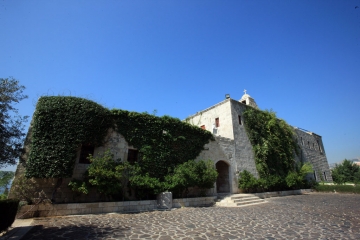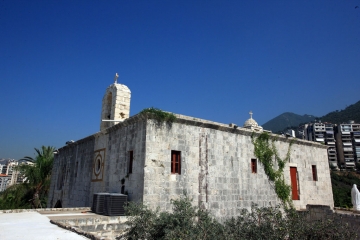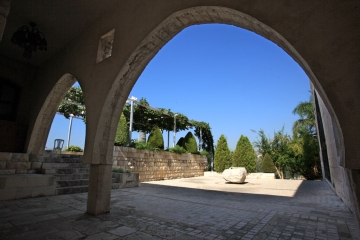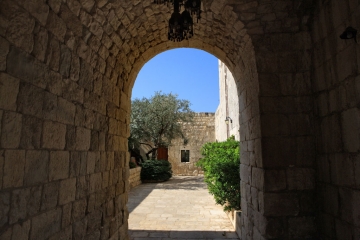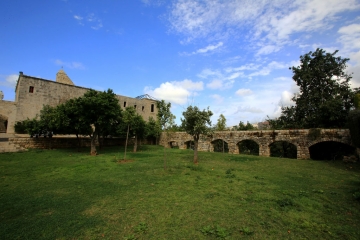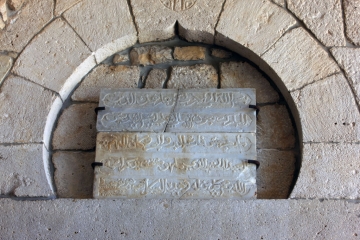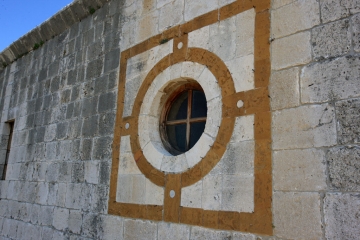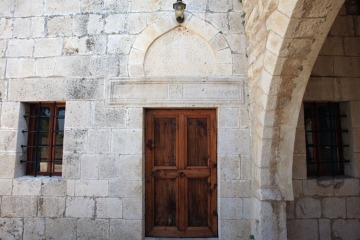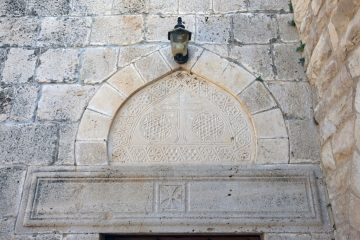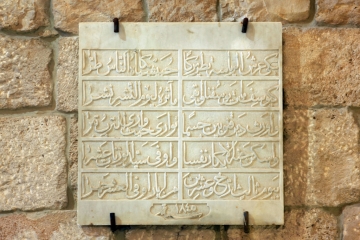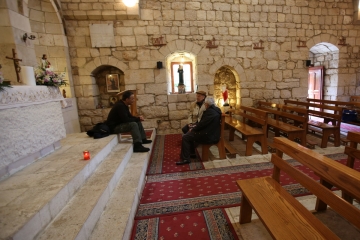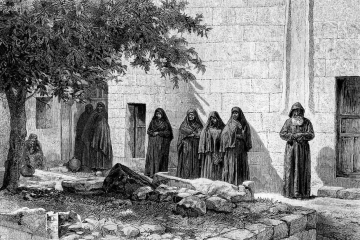دير مار جرجس - علما
بَعدَ وفاة البطريرك يوحنّا الحلو في 12 ايار عام 1823، اجتمع الأساقفة الموارنة في كنيسة دير سيّدة قَنّوبين في وادي قاديشا، وانتخبوا مطران طرابلس يوسف حبيش بطريركاً، وكان ذلك في 25 أيار، أي بعد ثلاثة عشر يوماً من وفاة البطريرك الحلو. ونال البطريرك الجديد دِرِع التثبيت من البابا لاوون الثاني عشر (1823-1829) في 3 أيار 1824.. رغم أنه، بِحَسب قانون الانتخابات البطريركية آنذاك، قد جَرى تَجاوز نُقطَتين، أولاهُما أن يكون الأسقف المُنتخَب بطريركاً قد تجاوز سِنَّ الأربعين، والثانية ان يَحصُل على ثُلثَي أصوات المُقترعين، ولَكِنَّ تَثبيته مِن قِبَل البابا أزال كُل شكّ ٍ حول شرعية انتخابه. ذلك إن البطريرك حبيش كان، عند انتخابه، من أصغر البطاركة الموارنة سِنّاً، إذ كان إذ ذاك في عُمر السِتة وثلاثين عاماً.
وهو أول بطريرك يُقيم في دير سيّدة بكركي، إذ عَمِل على ترميمه وجَعله مَقرّاً شَتوياً للبطاركة، وأمضى فيه فترةً طويلةً من عهده. ولَكِنَّ لَمّا كان قد أقام أيضاً في دير مار جِرجِس علما، الذي هو وَقف عائلته آل حبيش في قرية ساحِل علما، كونه كان إذ ذاك قد باشَر بترميم دير سيّدة بكركي، فقد رأينا ان نأتي على سيرته مُفَصَّلة في تحدُّثنا الآن عن هذا الدير.
يقول صاحِب كتاب "المُقاطعة الكسروانية" الأب منصور الحتّوني أنه، في سنة 1718، تَجَدَّد دير مار جِرجِس علما من الخوري ياغي حبيش الذي صار مطراناً باسمه. وهذا الدير المَذكور هو السابع عشر من أديرة كسروان المُتجَدِدَة، أمّا كنيسته فقد تَكَرَّست سنة 1726.
ويروي الدكتور شارل رزق الله، في كتابه "آل حبيش في التاريخ اللبناني (1516-1860)"، إن دير مار جِرجِس علما، بناه الحُبيشيون أبناء ساحِل علما، وإن البطريرك يوسف حبيش كان يقصد إليه من وقتٍ إلى آخر. وبانيه هو الشيخ يوسف ياغي حبيش سنة 1718، وقد ترأس عليه إثر إرتقائه إلى درجة الكهنوت في السنة نفسها.
وقد طالعنا أنطوان شعبان بمقال له بعنوان "العائلات اللبنانية ... رحلة في جذور التاريخ (آل حبيش)" يقول فيه: "إن المطران يوسف ياغي حبيش هو ابن الشيخ ياغي بن ضاهر بن يونس بن سليمان بن حبيش، وُلد في قرية ساحِل علما في بلاد كسروان سنة 1675، دَرَس مَبادِىء اللُغتين السِريانية والعربية على يد أحد عُلماء البلدة، واستَهَل أعماله بإنشاء دير في ساحِل علما على اسم القديس جِرجِس. وقد حَمَل ابن أخته الشيخ عاد الخازن على تأسيس دير سيدة البزاز في حارة صخر.. وأعطاه قِطعَة أرض من أملاكه لهذا الغرض. كَما دَفَع صُهره الشيخ نِمر الخازن من عجلتون، إلى إنشاء دير في قرية بلونة على اسم النبي الياس. ومِمّا يروى عنه أنه خَرَج يوماً من ديره، فلاقاه مُتسول فقير واستعطاه، ولمّا لم يكن يَحمِل شيئا من النقود فقد عَمَد إلى ردائه ودَفَعَه للفقير، ولمّا آب إلى الدير سألته الرئيسة عنه فأجابها: "أعطيته يا اختي للمسيح". توفاه الله في 2 شباط 1770.
فَنَحنُ إذن إزاء بعض التناقضات بين المُتكلمين عن هذا الدير، فبينما يقول الحَتّوني إن مُجدِّده، وليس بانيه، هو الخوري ياغي حبيش الذي صار مطراناً باسمه.. يقول الدكتور رزق الله إن بانيه هو الشيخ يوسف ياغي حبيش، وإنه ترأس عليه إثر ارتقائه إلى درجة الكهنوت، مِمّا يُفيد أن هذا الشيخ هو الذي بناه وليس مَن جدَّده فقط، وإنه بناه عندما كان لا يزال عِلمانياً، ولكنه ترأس عليه بعد أن أصبح كاهناً، ولا يُشير إلى أنه أصبح مطراناً.
أمّا أنطوان شعبان فيؤكد ان الباني هو نفسه أصبح مطراناً، وتَشَهد على صَواب وِجهَة نظره ، لوحة حَجَرية مُثبتة في جَدار كنيسة الدير تَحتوي أبياتاً شِعرية تُؤرِّخ لوفاة الباني، ونَستَدِل على أنه هو المَقصود بها مِمّا وَرَدَ في البيت الأول من هذه المَقطوعة.. وفي ما يلي ابياتها:
ما مات حبرٌ قد توارى في الثرى وله مآثر في البريّة خالــدَهْ
ديرٌ بناه ومار جِرجِس سوره ولكَم تحصَّنَ ضمنه من عابدَهْ
نادى حُبَيْشٌ من ذرى تاريخه: "فبه لأشكر فضلَ يوسفَ حامدَهْ"
في 2 شباط 1770
وَواضِح ٌمن تَسمية المُرثيّ بالحبر أنه كان أسقفاً، وهو ما يَحسُم الأمر بين كونه علمانياً في البدء ثم سيم كاهناً فمطراناً.. كما وَرَدَ في كتاب "برنامج أخوية القديس مارون" لمؤلّفه يوسف خطّار غانم.
أمّا عن الدير فهو يقع في أسفل قرية ساحِل علما، وهو عبارة عن مبنىً صغير يتألَّف من طابقين مع بهوٍ وقبوٍ وكنيسة. ويقول لويس القسيس، في كتابه "ساحِل علما في التاريخ - الأوقاف"، أن مَوقِعَه هو إلى الجِهة الشمالية الشَرقية من مدينة جونيه، ويربُض على الكَتِف الجنوبية لوادي علما قبالة مُنتَصَف الخليج على علوّ 165 متراً. كذلك وصفه الرَحّالة الفرنسي لويس لورتيه، في كتابه "مُشاهدات من لبنان" بقوله: "وَصلنا إلى أكمة علوُّها مئة وستّون متراً يقوم عليها دير ساحِل علما في قلعةٍ من قلاع القرون الوسطى. وهذه القلعة هي كناية عن بناياتٍ واسعة مؤلَّفة من كتلٍ من المساكن يتصل بعضها ببعض، يُهيمِن عليها جرسٌ صغير، وأبوابها مُصمَتة بأقفالٍ ثقيلة.. فُتحت أمامنا على مَمشىً غوطيّ يؤدّي إلى صَحنٍ تُحيط به أروقة الدير وتُظلّله زيتونة دَهرية".
هناك لوحة رخامية مُثْبَتة فوق المدخل الشمالي لكنيسة الدير تؤرّخ بناءَه بالعبارة التالية:
"بسم (باسم) الله الحيّ الأزليّ كمل عمار هذا الدير
المبارك بقوَّته تعالى على اسم القدّيس
مار جِرجِس فارس البرّ والبحر، وكان المُهتمّ
العبد الحقير الذي ما هو مستحقّ يُذكر اسمه
ألله يرحم كل مَن له في هذا الهيكل تعب، 1718".
وعلى يَمين المَدخَل المذكور نُقش صليب بشكله العاديّ وعلى أطرافه ثلاثة صلبانٍ صغار ، وهي طريقة نادرة في رسم الصليب ترمز إلى انتشار المسيحية في أربعة اقطار العالم.
ومَدخل الكنيسة الغربيّ يعلوه نقشٌ حَجَريّ يُمثّل الصليب على الشَكل الذي غدا شعاراً لجَمعية المُرسَلين اللبنانيين، مِمّا يُعتَقَد على إن المُرسَلين إستوحوا شِعارهم من هذا الرمز، وفوق الصليب المذكور توجَد نقوش وزخارف فنيّة .
كذلك، في بهو الدير، نُقِش صليب بِشكلِه القديم، أي الرامز إلى الطبيعتين والمشيئتين في المسيح، وهو الذي اعتمده الموارنة في أيام الجَدَل حول هذه المسألة تدليلاً على اعتناقهم هذه العقيدة. كما يلفت النظر في الكنيسة ان واجهتها الشرقية تعلوها زخارف مؤلَّفة من صلبانٍ وغيرها مع نجمة داوود.
ويتكلم لويس القسيس، في كتابه المُشار اليه، عن هذا الدير ، فيقول إنه بُني من حجرٍ صَخريّ، وضَمَّ جِناحَين يحتويان على كنيسة وسَبعٍ وعشرين غرفة ومَماشٍ وخلافها. والجِناح الشماليّ منه يحتوي على طابقَين، الأرضي ويضمّ كنيسة مار جِرجِس... وصالوناً وداراً وغرفة سفرة وغرفة مؤونة ومطبخاً وبئر ماءٍ ودرجَين مسقوفَين يُصعَد منهما إلى الطابق الأول الُمحتوي على عشر غرف وممشى مسقوفة كلها بالخشب والتراب، ودرج مسقوف يقود إلى السطح.
أمّا الجناح الجنوبي فمؤلَّف من طابقين: السُفليّ، ويَحتَوي على ثلاثة أقبية عقد، والأرضي المُحتوي على مَدخلٍ وإيوان وإحدى عشرة غرفة صغيرة للِسَكن وغرفة للحَطَب وكُلها مَسقوفة بالخشب والتراب، وفسحة بين الجناحين وبركتَي ماء. وإلى الجهة الشمالية من الدير بناء ثالث تابع له يحتوي على أربع غرف وقبوٍ للحطب وطاحونٍ خَرِبة. وفي الجناح الشمالي غرفة مَعتمة لها باب واحد وكوَّة صغيرة.
أمّا الكنيسة فارتفاعِها عشرة أمتار، وطولها أحد عشر متراً وعرضها سبعة أمتار، جدرانها من الكِلس العريض وسَقفها عَقد. مَذبحها الكبير هو على اسم القديس جِرجِس وتتصدَّره لوحة زيتية لمار جِرجِس من رسم بسكال القاضي، أحد أبناء ساحِل علما. وهو يقوم إلى الجهة الشرقية، وعن يمينه مَذبح صغير على اسم العذراء مريم، وعن شماله مَذبح صغير آخر على اسم القديس يوسف.
والجدير بالذِكر ان رئيس الدير لفترة طويلة من عهد البطريرك يوسف حبيش، كان شقيقه الخوري فيليبّوس حبيش. ويُذكر ان هذا الدير قد شَهِد حياةً رهبانيةً نسائية لعقودٍ طويلة، إلى ان اضمحلّت الحياة الرهبانية فيه مع بداية القرن العشرين، وكانت آخر راهباته فريدة حبيش. وبعد ذلك أُقفل الدير، فساده الخراب..إلى ان عمد الشيخ جوان نبيه حبيش وشقيقه الشيخ يوسف إلى ترميمه كما هو في حلّته الحالية.
وساكن هذا الدير لفترةٍ من الزمن (أثناء ترميم دير سيّدة بكركي)، البطريرك يوسف حبيش، هو سَليل الأسرة التي تَملِكُه كوقفٍ عائليّ: آل حبيش في ساحِل علما.
وُلد هذا البطريرك في ساحِل علما في 23 نيسان سنة 1787. اسمه بالولادة يعقوب. سِيم كاهناً في 26 حزيران 1814 مُتخذاً اسم "يوسف" في الكهنوت. رقّاه البطريرك يوحنّا الحلو إلى الدرجة الأسقفية يوم أحد الأبرار والصِدّيقين في 30 كانون الثاني 1820، وانتُخب بطريركاً في 25 ايار 1823، أمّا رِسامته البطريركية فقد تمَّت في 29 ايار في كنيسة سيّدة قَنّوبين.
وهو أول بطريرك يَتخَرَّج من مدرسة عين وَرقَة، لذلك بذل جِهده في انجاحها ورَفع مُستواها العلميّ. واهتمامه بالعلم دَفعَه أيضاً إلى تحويل دير مار عبدا هرهريّا إلى مَدرَسة عمومية للطائفة المارونية، وذلك في العام 1830، وكذلك دير مار سركيس وباخوس في ريفون الذي حوَّله إلى مدرسة عمومية للطائفة عام 1832، كما أسَّس مدرسة غزير بالتعاون مع الآباء اليسوعيين عام 1843، ومدرسة مار شلّيطا في مشموشة.
وقد أبدى اهتماماً خاصاً بالرهبان والراهبات، مُعتبراً أن الرَهبنة هي قوة عَظيمة للكنيسة، وإذا أُحسن تنظيمها، فإنها تَستَطيع القيام بأعظم الأعمال وتقديم أجَلّ الفوائد. وقد رَفَع تقريراً إلى البابا غريغوار السادس عشر(1831-1846) في 23 كانون ال أول 1831 أكد فيه أنه سَعى لتحقيق إصلاحات، ولتطبيق مُقرَرات المَجمَع اللبناني الذي إنعقد عام 1736.. خصوصاً في ما يتعلق بإلزام الكهنة بأن يكونوا من المُتعلمين في رعاياهم، وبِفَصل الأديرة المُختلطة حيث يعيش الرهبان والراهبات في ديرٍ واحد إنما في جناحين، وتحويل الرهبنات إلى رهبنات رجّالية وأخرى نسائية، وقد تأخر تنفيذ هذا البند الاخير بسبب ما لقيه من المُعارضَة الشديدة من جانب الأساقفة، لكون عادة الأديرة المُختلطة هي مِن عادات الكنائس السِريانية الشرقية القديمة. كما أن هذا البطريرك أقرَّ عدداً من القضايا الطقسية التي تندرج في إطار "ليتنة" الطقوس المارونية.
قال هنري غيز قنصل فرنسا في بيروت ما بين عامَي 1825 و 1839، في كتابه "بيروت ولبنان"، إن عهد البطريرك يوسف حبيش شهد مآزق حَرِجَة جداً.. استطاع خلالها حِماية حُقوق طائفته وصَونِها عن النَكَبات الجُلّى مِثل تلك التي أصيبت بها في السابق.
ويقول المؤرّخ الأباتي بولس نعمان إن بطريركيته كانت "نِضالاً" في سبيل حِماية حقوق الكنيسة من الحُكام المَدنيين ومُداخلات الموفدين البابويين وعمل المُرسَلين، وإنه سَعى إلى تَحقيق تقدُّمٍ روحيّ وعِلميّ واجتماعيّ للطائفة من خِلال نَشر التعليم بين الكهنة والرعايا، وإلى تنفيذ مُقررات المَجمَع اللبناني.. وتنظيم إدارة الكنيسة على أسُسٍ حديثة.
وعلى الصعيد السياسي وقف ضُد الحكم المَصري في لبنان والمَظالِم التي ارتكبها، ودَعَمَ عملية تحرير "بلاد الشام" من هذا الحُكم التي قرَّرتها الدولة العثمانية بالإتفاق مع "دول الحلفاء"، فكان لِمَوقفه هذا أثره لدى الباب العالي في الأستانة.. الذي أمر بتعيين ممثل للطائفة المارونية في البلاط السلطاني أسوةً بسائر الطوائف، كما قلَّده البِلاط أرفع الأوسِمَة العُثمانية وهو النيشان العُثماني المُرَصَّع.. الذي قبله بِتَحفُّظ ولم يُزيّن به صدره أبداً.
وفي كتاب عنوانه "آل حبيش في التاريخ" للشيخ خليل رشيد حبيش ورد ما يلي:
"وقد احتاط البطريرك الحُبيشيّ، فأحاط الطائفة برجال من أكفئهم فَضيلة وحِكمة وعِلماً وغيرة.. ساعدوه في مَهامِه ومَشاريعه الإصلاحية والعُمرانية والثقافية. فَنَظَّم شؤون الطائفة ومؤسساتها وأوقافها إكليروسها أحسن تنظيم، وعَزّزها وأنماها وحَماها من كل كارثة وفساد، وكان إذا دَهَمَها خطر عالَجَه بِفِطنَة، فأبعده عنها.
وكان أنه في أواسط القرن التاسع عشر أصبح النشاط التبشيريّ للإنجيليين في الشرق ذا دعائم قوية، إذ أُنشئ كثيرٌ من المَطابِع، وأُسّست لمُساعدة هذا النشاط "جمعية الإستشراق الاميريكية". وامتدَّ هذا النشاط من بيروت إلى صيدا وطرابلس ودير القمر وحُمص، فآثار قلق البطريركية المارونية البالغ، لا سيَّما وان الرهبان المَفصولين من الأديرة وغير المقبولين فيها، راحوا يَنضَمّون إلى البعثات القائمة بالتبشير الإنجيلي، إلى ان حَصَل الحَدَث الأبرز في تموز 1823.. وهو إستئجار المُرسل الأميركي لويس غاي مَدرسة عينطورة التي كانت مُهمَلة منذ العام 1773.. خادعاً بذلك القاصد الرسوليّ. فَبَعَث مَجمَع نَشر الإيمان في روما رسالةً إلى البطريرك يستوضحه فيها عن هذه المسألة التي تمَّت على يد النائب البطريركي في جبل لبنان المطران يوحنّا مارون العَضِم، وذاكراً ان "الإرساليات الإنجيلية تَهدِف إلى نَشر الزؤان في جبل لبنان". فأصدَر البطريرك على الأثر مَنشوراً عامّاً حَرَّم فيه كُتُب هذه الجماعة، وحَظَّر على المؤمنين حُضور صَلواتهم وسَماع مواعِظِهم والتَعلُّم في مدارسهم ومباحثتهم في أمور الديانة. فخضع أبناء الطائفة جميعاً لطلب البطريرك حالما بَلَغَهُم منشوره الأول ضد هؤلاء، و"أحرقوا كتبهم في الحال" كما جاء في إحدى الوثائق المَحفوظة في سِجلّ البطريركية المارونية وتعود إلى تلك الفترة.
وفي عهد هذا البطريرك نشأ نظام القائمقاميتين الذي عارضه مُطالباً بابقاء جبل لبنان موحَّداً. ولكنَّ الدولة أصرَّت على إنشائه، فقامَت في الجَبل قائمقامية مَسيحية في شماله وقائمقامية دِرزية في جُنوبه.
ومن أعماله العمرانية في ما يَختص بالأديرة إنه رمَّم دير سيّدة بكركي كما ألمحنا إلى ذلك، كما أنه كان أول بطريرك سَكن في منطقة الديمان .
وفي تِلكَ الأثناء كانت الأجواء السِياسية تنعكس إيجابياً على الموارنة، إذ كانت العائلة الشهابية الحاكمة قد أخذت باعتناق المسيحية والإنضمام إلى الكنيسة المارونية منذ العام 1770 ولو أنها ظلَّت كاتمةً ذلك. ولكنَّ بعد وفاة بشير الثاني وتولّي بشير الثالث الإمارة في الجبل، وذلك في 3 ايلول 1840، جاهر الشهابيون بِمُعتَقَدهم الجديد، مِمّا حَقَّق نفوذاً بالغاً للموارنة وبطريركيتهم. وتعزَّز هذا النفوذ مع مُساهمة الموارنة وبطريركهم في مقاومة الحُكم المصري، إذ تسلَّحوا بِسلاحٍ إنكليزي أمَّنه لهم البطريرك للإشتراك في طَرد جيش إبراهيم باشا من البلاد، رُغمَ ما حقَّق من إصلاحاتٍ إدارية واقتصادية وكفل من الحرية الدينية، وذلك بِسَبَب الضرائب الباهظة التي فَرَضَها وسِياسة التجنيد الإجباريّ التي انتهجها، وموقفهم هذا أكسبهم رضا الدولة العثمانية عنهم.
فهذان التَطَوران أدّيا إلى زيادة ثقل الموارنة وتقوية دورهم في السياسة اللبنانية، وإلى تصاعد دور البطريركية المارونية، فكان ذلك من المُقدّمات لقيام فتنة العام 1840 التي كانت أول حربٍ أهلية في تاريخ لبنان المُعاصر، والتي كان من أسبابها تفرُّد الدروز بالإقطاع بينما أغلبية الشعب كانت من الفلاّحين الموارنة، يُضاف إلى ذلك رَغبة الموارنة بِلِعب دورٍ بارز وأساسيّ في حياة الجبل.. مَدعومين من السلطان العثمانيّ نفسه. فكانت ردَّة الفعل من الدروز تَحالفِهم مع الإنكليز.. في حين كان الموارنة يَكرَهون هؤلاء لدَعمِهم المُبشّرين الإنجيليين، فكان أن قوّوا أواصِر تحالفهم مع فرنسا بمُباركة البطريرك.
فَراح الدُروز يَشترون السِلاح الذي خَلَّفَه جيش إبراهيم باشا وكان يباع بأسعارٍ بَخِسَة، فقام القِتال الطائفيّ الذي قال المطران يوسف الدبس إن البطريرك حبيش مات بِسَبَبِه حُزناً وكمداً، وخَلَّدَت ذكرى وفاته لوحة شعّرية مُثبتة في كنيسة الدير في ما يلي ابياتها:
على عرش الرياسة بطريركاً حبيشياً بكاه الناس طُرّا
كيوسفَ مات يوسفنا وأبقى مآثرَه ليوم الحشر نشرا
وأورث دير قنّوبينَ جسماً توارى حيث وارى التربُ تبرا
وأسكن جنة الأبكار نفساً وأوفى سيّد الوزناتِ عشرا
بيومٍ ثالثٍ أُرَّخ وعشرين من أيار أوفى العشر جهرا
سنة 1845
أجَل، مات البطريرك يوسف حبيش في 23 ايار سنة 1845 في الديمان، فدُفِن في مغارة القديسة مارينا في قنَّوبين تيمُّناً بها على غرار الكثيرين من البطاركة أسلافه.
Saint George Monastery – Alma
After the death of Patriarch Youhanna El Helou on May 12, 1823, the Maronite bishops gathered in the church of the Monastery of Our Lady of Qannoubine in Wadi Qadisha and elected the Metropolitan of Tripoli Youssef Hobeish as Patriarch on May 25, thirteen days after the death of Patriarch El Helou. The new patriarch received the confirmation shield from Pope Leo XII (1823-1829) on May 3, 1824, although, according to the patriarchal election law at the time, two rules had been crossed, the first of which was that the bishop elected as a patriarch should be over the age of forty, and the second was that he must obtain two-thirds of the votes cast. However, his confirmation by the Pope erased all doubt about the legitimacy of his election. That is because Patriarch Hobeish was, at the time of his election, one of the youngest of the Maronite patriarchs, as he was at the time thirty-six years old. He is the first patriarch to reside in the monastery of Our Lady of Bkerki, as he worked on restoring it and making it a winter residence for the patriarchs, and spent a long period of his reign there. But, because he also resided in the monastery of St. Georges Alma, which is the property of his family, the Hobeish family in the village of Sahel Alma, since he had at that time begun the restoration of the monastery of Our Lady of Bkerki, we decided to mention his detailed biography in our chapter about this monastery
The author of the book “Al-Muqata’a al-Kasrawaniyah (the District of Keserwan),” Father Mansour al-Hatouni, says that, in 1718, the monastery of St. George was renovated. It was the seventeenth of the renewed Keserwan monasteries. As for its church, it was consecrated in 1726. Dr. Charles Rizkallah tells, in his book “The Hobeish Family in Lebanese History (1516-1860),” that the St. Georges monastery in Alma was built by the Habeishites, who originated from Sahel Alma, and that Patriarch Youssef Hobeish used to visit it from time to time. Its builder was Sheikh Youssef Yaghi Hobeish in 1718, and he presided over it after being promoted to the rank of priest in the same year
Professor Antoine Shaaban wrote an article entitled “Lebanese Families… A Journey into the Roots of History (The Hobeish Family),” in which he says: “Bishop Youssef Yaghi Hobeish is the son of Sheikh Yaghi Bin Daher Bin Younes Bin Suleiman Bin Hobeish. He was born in the village of Sahel Alma in the district of Keserwan in 1675. He studied the principles of the Syriac and Arabic languages at the hands of one of the town’s scholars and began his work by establishing a monastery in Sahel Alma, named after Saint George. His nephew, Sheikh Aad, urged Al-Khazen to establish the monastery of Our Lady of Al-Bzaz in Haret Sakhr and donated to him a plot of land from his property for this purpose. He also pushed his brother-in-law, Sheikh Nimr al-Khazen, from Ajaltoun, to establish a monastery in the village of Ballouneh, named after the Prophet Elias. It is narrated that he went out one day from his monastery, and met a poor beggar in the street. He wasn’t carrying any money, so he took his robe and gave it to him instead, and when he returned to the monastery, the abbess asked him about it, and he replied: “I gave it, sister, to Christ.” He passed away on February 2, 1770. We notice some contradictory information related to this monastery; while al-Hatouni says that its renovator, not its builder, is the priest Yaghi Hobeish, who became a metropolitan by the same name, Dr. Rizkallah claims that its builder is Sheikh Youssef Yaghi Hobeish and that he presided over it after his ascension to the priesthood, which indicates that this Sheikh was the one who built it and not just the one who renovated it and that he built it when he was still secular, but he presided over it after he became a priest. He doesn’t mention him becoming a metropolitan
As for Professor Antoine Shaaban, he confirms that the builder himself became a metropolitan, and his point of view is validated by the first verse written on a stone plaque installed in the wall of the monastery church containing poetic verses commemorating the death of the builder. As for the monastery, it is located at the bottom of the village of Sahel Alma. It is a small two-story building with a hall, a basement, and a church. Professor Louis al-Qassis, in his book "Sahel Alma in History - Endowments", says that its location is to the northeastern side of the city of Jounieh, and it lies on the southern shoulder of the valley of Alma, opposite the middle of the Gulf, at an altitude of 165 meters
The French traveler Louis Lorte also described it, in his book "Views from Lebanon", by saying: "We reached a mound of one hundred and sixty meters high, on which the Sahel Alma Monastery stands, in one of the medieval castles. This fortress is a metaphor for wide buildings composed of blocks of dwellings connected to each other, dominated by a small bell, and its doors are solid with heavy locks. It opened in front of us on a Gothic walkway that leads to a courtyard surrounded by the corridors of the monastery and shaded by an ancient olive tree
There is a marble plaque installed above the northern entrance to the monastery church, dating its construction with the following phrase : “In the name of the living and eternal God, the construction of this monastery was completed
Blessed be His power, may He be exalted
It was named after Saint Gerges, the Knight of Land and Sea,
Under the care of the wretched servant whose name is not worthy to be mentioned
May God have mercy on everyone who put effort in the construction of this temple, 1718
To the right of the aforementioned entrance, a crucifix in its normal shape is engraved with three small crosses on its edges, a rare method of drawing the cross symbolizing the spread of Christianity in the four corners of the world. The western entrance to the church is topped with a stone inscription representing the cross in the shape that became the emblem of the Lebanese Missionaries Association, which indicates that the missionaries were inspired by this symbol, and above the mentioned cross there are inscriptions and artistic decorations. In the hall of the monastery, a cross was engraved in its ancient form, which symbolizes the two natures and the two wills of Christ, which the Maronites adopted during the days of controversy over this issue, as evidence of their embrace of this doctrine. It is also striking in the church that its eastern facade is decorated with crosses and the Star of David
Professor Louis al-Qassi wrote about this monastery, saying that it was built of rocky stone, and included two wings containing a church and twenty-seven rooms, walkways, and the like. The northern wing included two floors, the ground one which included the Church of St. George, a salon, a house, a dining room, a pantry room, a kitchen, a water well, and two roofed stairs from which one climbs to the first floor, which was composed of ten rooms, a walkway all roofed with wood and dirt, and a roofed staircase that leads to the roof. As for the southern wing, it is made up of two floors: the lower one, which contains three vaults, and the ground one which contains an entrance, an iwan, eleven small rooms for housing, a room for firewood, all of which are roofed with wood and dirt, a space between the two wings and two pools of water. To the north side of the monastery is a third building belonging to it, which contains four rooms, a cellar for wood, and a ruined mill. In the north wing are a dark room with one door and a small alcove. As for the church, it is ten meters high, eleven meters long, seven meters wide; its walls are made of broad lime and its roof is a knot. Its great altar is named after Saint George, and it is topped by an oil painting of Saint George, drawn by one of the inhabitants of Sahel Alma, Mr. Pascal Al-Qadi. It stands to the east, and to its right is a small altar named after the Virgin Mary, and on its left is another small altar named after Saint Joseph
It is worth mentioning that the abbot of the monastery for a long period during the reign of Patriarch Youssef Hobeish was his brother, the priest Phillipus Hobeish. It is noteworthy that this monastery witnessed women's monastic life for many decades until the monastic life in it withered at the beginning of the twentieth century, and the last of its nuns was Farida Hobeish. After that, the monastery closed its doors and fell into ruin, until Sheikh Joan Nabih Hobeish and his brother Sheikh Youssef renovated it and gave it its current shape
Patriarch Youssef Hobeish, who is the descendant of the family that owns this monastery, resided in it for some time. This patriarch was born in Sahel Alma on April 23, 1787. His birth name is Yaqoub. He was ordained a priest on June 26, 1814, taking the name "Joseph" in the priesthood. Patriarch Youhanna El-Helou promoted him to the episcopal rank on January 30, 1820, and he was elected patriarch on May 25, 1823, and his patriarchal ordination took place on May 29 in the Church of Our Lady of Qannoubine. He is the first patriarch to graduate from the Ain Warqa School, so he made every effort to make it a successful institution and raise its scientific level. His interest in science also prompted him to transform the monastery of Mar Abda Hararia into a public school for the Maronite community, in the year 1830, as well as the monastery of Saint Sarkis and Bacchus in Rayfoun, which he turned into a public school for the community in 1832. He also founded Ghazir School in cooperation with the Jesuit fathers in 1843, and the Mar Shallita school in Mashmousheh. He showed a special interest in monks and nuns, considering that monasticism is a great strength for the Church, and if it is well organized, it can do the greatest work and yield the most benefits. He submitted a report to Pope Gregory XVI (1831-1846) on December 23, 1831, in which he affirmed that he sought to achieve reforms and to implement the decisions of the Lebanese Synod that convened in 1736, especially about compelling priests to complete their education in their parishes, and separating mixed monasteries where monks and nuns lived in two different wings, and the conversion of the monasteries into men’s and women’s monasteries. The implementation of this last clause was delayed due to the strong opposition it encountered on the part of the bishops because the custom of mixed monasteries is a custom of the ancient Eastern Syriac churches
This patriarch also ruled positively on several liturgical issues that fall within the framework of the "Latinization" of the Maronite rites. Henri Guise, Consul of France in Beirut between 1825 and 1839, said in his book "Beirut and Lebanon" that the era of Patriarch Youssef Hobeish witnessed very critical predicaments, during which he was able to protect and preserve the rights of his sect from clear calamities such as those he had suffered in the past
Historian Abbot Boulos Naaman says that his patriarchate was a "struggle" to protect the rights of the Church from civil rulers, the interventions of papal delegates and the work of missionaries, and that he sought to achieve spiritual, scientific, and social progress for the sect by spreading education among priests and parishioners, and to implement the decisions of the Lebanese Synod, and to organize Church management on modern foundations. On the political level, he stood against the Egyptian rule in Lebanon and the injustices it committed and supported the process of liberating “Bilad al-Sham” from this rule, which was decided by the Ottoman Empire in agreement with the “Allied Powers.” This position had an impact on the Sublime Porte in Astana which ordered the appointment of a representative of the Maronite sect at the royal court, like all the other sects. He received the highest of Ottoman decorations, which is the studded Ottoman medal and he accepted it with discretion and never adorned his chest with it. In a book entitled “The Hobeish Family in History,” by Sheikh Khalil Rashid Hobeish, the following was stated: “Patriarch Hobeish was careful and surrounded the sect with wise, virtuous, knowledgeable, and zealous men. They helped him accomplish his tasks and implement his reform, construction, and cultural projects. He organized the affairs of the sect, its institutions, endowments, and its clergy in the best way possible, strengthened it, developed it, and protected it from disaster and corruption
In the mid-nineteenth century, the missionary activity of evangelists in the East was going strong, as many printing presses had been established, and the "American Orientalist Society" was supporting this activity. This activity extended from Beirut to Sidon, Tripoli, Deir al-Qamar, and Homs. This became a great cause for concern for the Maronite Patriarchate, especially since the dismissed monks from the monasteries and those not accepted in them began to join the existing missions of evangelistic preaching, until the most prominent event occurred in July 1823. An American missionary. Louis Gay, rented the school of Aintoura, which had been neglected since 1773, deceiving by his action the apostolic representative. The Congregation for the Propagation of the Faith in Rome sent a letter to the Patriarch asking him for clarification on this issue, and the Patriarchal Vicar in Mount Lebanon, Archbishop Youhanna Maroun Al-Adham, wrote back that “the Evangelical missions aim to spread discord in Mount Lebanon.” The Patriarch then issued a general circular prohibiting the books of this mission, and forbidding the believers to attend their prayers, hear their sermons, learn in their schools, and discuss matters of religion with them. All the members of the sect submitted to the patriarch’s request and “they immediately burned their books,” as stated in one of the documents preserved in the Maronite Patriarchate’s registry dating back to that period
During the era of this patriarch, the Kaemakamite system was established, which he opposed by demanding to keep Mount Lebanon unified. However, the state insisted on establishing it, so it established a Christian Qaimqamiya in the north and a Druze Qaimqamiyya in the south. As we have already mentioned, he renovated the monastery of Bkerki and was the first patriarch to reside in Diman. Meanwhile, the political atmosphere reflected positively on the Maronites, as the ruling Chehab family had embraced Christianity and joined the Maronite Church since 1770, although it kept the matter quiet. However, after the death of Bashir II and with Bashir III assuming the Emirate of the Mountain, on September 3, 1840, the Chehabs professed their new belief, which had a great influence on the Maronites and their Patriarchate. This influence was strengthened with the contribution of the Maronites and their Patriarch in resisting the Egyptian rule, as they were armed with English weapons that the Patriarch secured for them to participate in the expulsion of Ibrahim Pasha’s army from the country despite the administrative and economic reforms that had been achieved and the guarantee of religious freedom, due to the exorbitant taxes and the policy of forced conscription that he imposed. And this position of theirs earned them the approval of the Ottoman Empire
These two developments led to an increase in the importance of the Maronites and the strengthening of their role in Lebanese politics, and the escalation of the role of the Maronite Patriarchate. This was one of the preludes to the outbreak of the strife of 1840, which was the first civil war in the contemporary history of Lebanon. Its causes were the attachment of the Druze to feudalism, while the majority of the people were Maronite peasants, in addition to the desire of the Maronites to play a prominent and essential role in the life of the mountain, with the support of the Ottoman Sultan himself. The reaction of the Druze was to ally themselves with the English, and, because the Maronites hated them for their support of the evangelical missionaries, they strengthened the bonds of their alliance with France with the blessing of the Patriarch. The Druze began buying the weapons left by Ibrahim Pasha's army, which were being sold at low prices, and the sectarian broke out. According to Bishop Youssef Al-Debs, Patriarch Hobeish died because of the grief and pain that it caused him
The memory of his death was immortalized by a poetic plaque installed in the monastery church, containing the following verses: On the patriarchate’s throne sat a patriarch that people cried over abundantly Just like Joseph, our Joseph died but left behind him deeds forever remembered He bequeathed to the monastery of Qannoubine a body buried beneath the soil And bequeathed to Heaven the purest of souls 1845. Yes, Patriarch Youssef Hobeish died on May 23, 1845 in Diman. He was buried in the cave of St. Marina in Qannoubine, in her honor, like many of his predecessors
